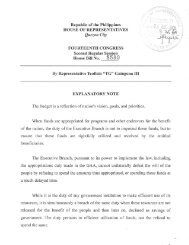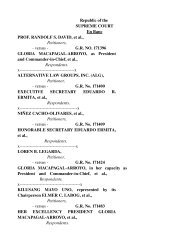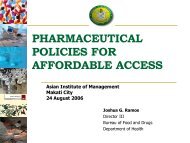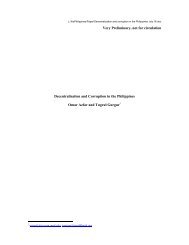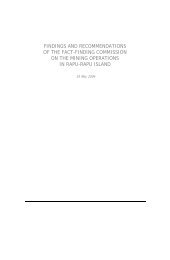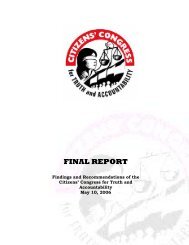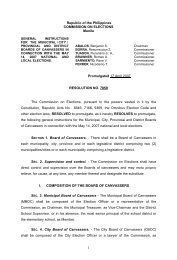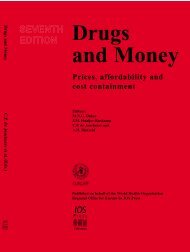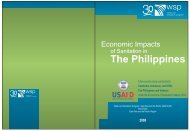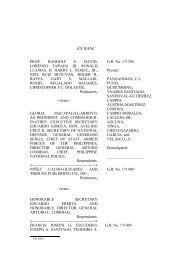The state of water resources in the Philippines - Greenpeace
The state of water resources in the Philippines - Greenpeace
The state of water resources in the Philippines - Greenpeace
You also want an ePaper? Increase the reach of your titles
YUMPU automatically turns print PDFs into web optimized ePapers that Google loves.
Based on 2003 data, 63 percent <strong>of</strong> ground<strong>water</strong> is consumed by <strong>the</strong> domestic<br />
sector and <strong>the</strong> rema<strong>in</strong><strong>in</strong>g is shared by agriculture (17 percent), <strong>in</strong>dustry (13<br />
percent), and o<strong>the</strong>r sectors (7 percent) (PEM, 2004). PEM 2003, on <strong>the</strong> o<strong>the</strong>r<br />
hand, reports that about 86 percent <strong>of</strong> piped-<strong>water</strong> supply systems use<br />
ground<strong>water</strong> as source.<br />
Estimated <strong>water</strong> withdrawals as <strong>of</strong> 2003, based on <strong>water</strong>-right grantees<br />
registered with NWRB is 77,456 MCM/year. About 60 percent <strong>of</strong> ground<strong>water</strong><br />
extraction is without permit, result<strong>in</strong>g <strong>in</strong> <strong>in</strong>discrim<strong>in</strong>ate withdrawal. Overabstraction<br />
from 6,441 registered wells has led to <strong>the</strong> lower<strong>in</strong>g <strong>of</strong> aquifers,<br />
result<strong>in</strong>g <strong>in</strong> sal<strong>in</strong>e <strong>in</strong>trusion and ground subsidence <strong>in</strong> some areas.<br />
B. Access to dr<strong>in</strong>k<strong>in</strong>g <strong>water</strong><br />
Accord<strong>in</strong>g to <strong>the</strong> “2005 Little Green Data Book” <strong>of</strong> <strong>the</strong> World Bank, one out <strong>of</strong> five<br />
Filip<strong>in</strong>os does not get <strong>water</strong> from formal sources. Only 77 percent <strong>of</strong> <strong>the</strong> rural<br />
population and 90 percent <strong>of</strong> those <strong>in</strong> urban areas have access to an improved<br />
<strong>water</strong> source and only 44 percent have direct house connections. Those without<br />
house connections access <strong>water</strong> from wells, spr<strong>in</strong>gs, communal faucets, and/or<br />
from small scale <strong>in</strong>formal providers (Madrazo, A., 2002).<br />
In <strong>the</strong> Philipp<strong>in</strong>es, supply and delivery <strong>of</strong> potable <strong>water</strong> <strong>in</strong> different parts <strong>of</strong> <strong>the</strong><br />
country is <strong>the</strong> responsibility <strong>of</strong> various government agencies and <strong>water</strong> utilities.<br />
Metro Manila is be<strong>in</strong>g served primarily by <strong>the</strong> Metropolitan Waterworks and<br />
Sewerage System (MWSS) through its two private concessionaires, <strong>the</strong> Maynilad<br />
Water Services, Inc. and <strong>the</strong> Manila Water Company, and by some private<br />
companies serv<strong>in</strong>g subdivisions. Water supply comes ma<strong>in</strong>ly from surface <strong>water</strong>.<br />
Metro Manila has four <strong>water</strong> treatment plants, namely: Balara Treatment Plants I<br />
and II, and <strong>the</strong> La Mesa Water Treatment Plants I and II.<br />
In o<strong>the</strong>r urban and fr<strong>in</strong>ge areas outside <strong>of</strong> Metro Manila, service is provided by a<br />
total <strong>of</strong> 594 <strong>water</strong> districts and 250 subdivisions with Certificates <strong>of</strong> Public<br />
Convenience (CPC). As <strong>of</strong> December 2004, o<strong>the</strong>r private suppliers and<br />
providers issued with CPC <strong>in</strong>clude: a total <strong>of</strong> 321 out <strong>of</strong> an estimated potential<br />
1,780 <strong>water</strong> service providers granted CPC, 500 Rural Water and Sanitation<br />
Associations (RWSA), 21 out <strong>of</strong> 156 <strong>water</strong> cooperatives, n<strong>in</strong>e economic zones,<br />
four private utility operators, and 46 peddlers/ship chandlers. <strong>The</strong>se <strong>water</strong><br />
districts and private utilities operat<strong>in</strong>g <strong>in</strong> different prov<strong>in</strong>ces are monitored and<br />
adm<strong>in</strong>istered by <strong>the</strong> LWUA and NWRB.<br />
<strong>The</strong> prov<strong>in</strong>cial rural areas are primarily served by <strong>the</strong> Local Government Units<br />
and cooperative <strong>water</strong> associations, with assistance from <strong>the</strong> Department <strong>of</strong><br />
Interior and Local Government (DILG), Department <strong>of</strong> Public Works and<br />
Highways (DPWH), and Local Water Utilities Adm<strong>in</strong>istration (LWUA) (Jamora, L.,<br />
2002).<br />
Water supplied by all sources <strong>in</strong> <strong>the</strong> Philipp<strong>in</strong>es is considered unsafe for dr<strong>in</strong>k<strong>in</strong>g<br />
without fur<strong>the</strong>r treatment. Outside <strong>of</strong> Metro Manila, <strong>the</strong>re are <strong>water</strong> treatment<br />
GREENPEACE | <strong>The</strong> <strong>state</strong> <strong>of</strong> <strong>water</strong> <strong>in</strong> <strong>the</strong> Philipp<strong>in</strong>es 27



